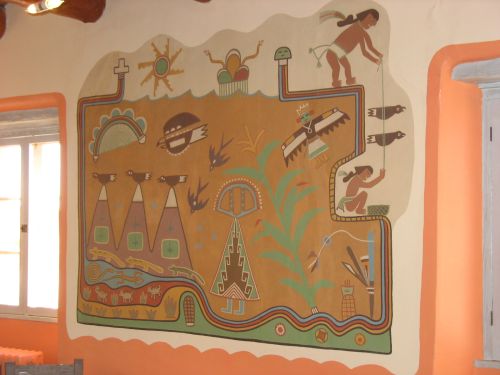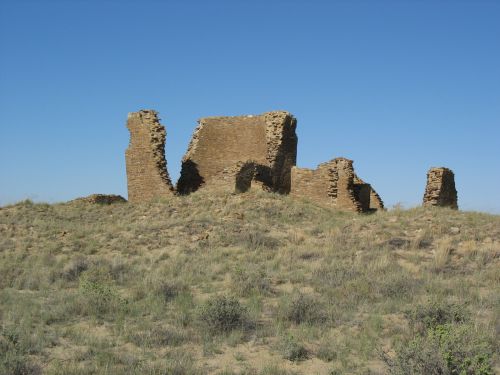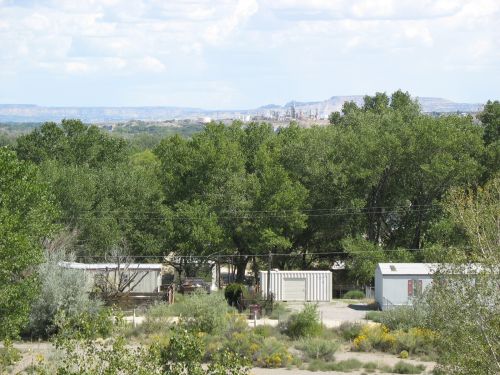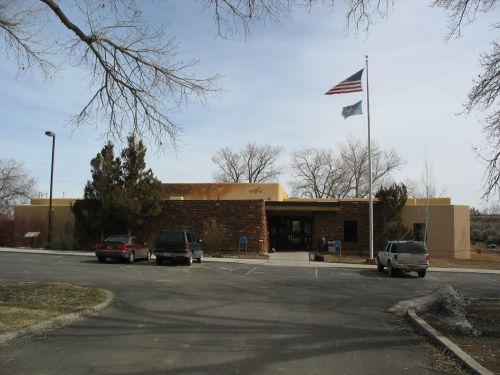
Looking North from New Alto
When I was working at Chaco, we would often get visitors who would complain about how hard it was to get there. They usually focused on the road in and asked why there wasn’t more effort to pave it and make it more accessible to the American public. After all, isn’t that what national parks are for? Well, no, I would often respond. The Park Service mission is preservation foremost and visitor services secondarily, and most of the time concerns about preservation trump concerns about accessibility and interpretation. There is one interesting exception at Chaco, but for the most part the park is concerned more with preserving the sites than with showing them to the public.

"Area Closed" Sign on Peñasco Blanco Trail
Some people were satisfied with this explanation, but many weren’t. I didn’t have much to say to those who took a more absolutist position on the right of the public to access the parks. That’s just a basic philosophical difference, and the best we could do was agree to differ.

Downtown Farmington, New Mexico
One thing I often thought about saying, however, was that it might be better to just build a full-scale model of Pueblo Bonito in downtown Farmington (or even Albuquerque). For a lot of the visitors who come to Chaco, it’s really just a matter of seeing Pueblo Bonito, marveling at it, and going on their way. They’re the ones who complain about how hard it is to get there; arguments about how the isolation is part of the point carry no water with them. I never actually said this, but I do wonder if it might be a good idea. One of the ways in which the two aspects of the Park Service mission are very much in tension is that preservation and visitation are not only different, they’re actually often in direct conflict. Visitor impacts are among the most serious threats to the preservation of the sites. Sometimes people deliberately vandalize the sites, carve their names one the canyon walls, or steal artifacts, but even the vast majority of visitors who don’t do anything deliberately nonetheless destabilize the sites just by being there, walking through them, inadvertently touching the walls, and so forth. The biggest single thing the park could do to improve preservation of the sites would be to limit public access to them.

Pueblo Bonito from Above
A full-scale replica of Pueblo Bonito in another location would have a similar effect: drawing the casual visitors away from the canyon and leaving it to the more serious people who are willing to brave the road to get there. There would be little need to recreate any of the other sites, except perhaps Casa Rinconada; Bonito is what people come to Chaco for.

Casa Rinconada, Looking North
It won’t happen, of course, but it’s not as crazy an idea as it sounds. I was reminded of it by Paul Barford’s recent post on an idea proposed by Trevor Watkins for dealing with the recent disputes among governments over some high-profile antiquities. The proposal is to make replicas indistinguishable from the originals, then trade both the originals and the replicas back and forth between the source countries and the countries that currently have the objects without telling the public if what they see is original or a copy. This seems like a bizarre thing to do, and I kind of doubt the source countries will be in favor of it (though they might like a version in which they get to keep the originals permanently and the acquiring countries have to make do with copies), but the proposal notes that there are actually some archaeological sites, particularly the Paleolithic caves at Lascaux and Altamira, that have full-scale replicas, and visitors seem to like them just fine and to even say that they are better than the originals because they allow better visibility of the interesting parts, which in the case of the caves are the cave paintings for which they are famous. This is kind of an extreme version of the reconstruction of prehistoric sites that was popular in the Southwest in the 1930s, moving beyond that only in that the replicas are not adding on to the originals but are separate entirely. In addition to being more convenient for visitors, this would also be better for preservation of the original sites. I think American archaeology might actually be moving in this direction too, with the reburial of Baker Village after excavation, with only the protective capping on the walls visible from the service, being an early indication.

Low Walls at Pueblo Alto
More directly relevant to Watkins’s proposal, perhaps, is the famous jet frog found in Room 38 at Pueblo Bonito by the Hyde Exploring Expedition in 1897. Often considered one of the most remarkable Anasazi artifacts known, the frog is made of jet with turquoise inlay forming its eyes and neck, and is intact except for a couple of pieces of inlay on the neck. Like all the rest of the material found by that expedition, the frog was sent to the American Museum of Natural History in New York, where it remains to this day, not on display but somewhere back in the storage cabinets.

Jet Frog Replica at Chaco Museum
There is, however, a jet frog prominently displayed in the museum at the Chaco visitor center. Although it is not labeled as such, this is an exact replica of the original, right down to the missing inlay pieces. Since the American Museum is notoriously protective of its collections, this is the best the park could do to show what the jet frog looks like. This is exactly what Watkins is advocating: exact replicas, put on display without any indication that they aren’t original. Unlike his proposal, of course, in this case the original and the replica don’t move back and forth, but any real-life implementation of the proposal would probably end up that way.

Museum of Chaco Culture
What all this goes to show, I think, is that most people who come to archaeological sites and museums to see the wonders of the past aren’t all that concerned with the “authenticity” of what they see. Indeed, for a lot of people an impressive reconstruction is preferable to an unimpressive original. We would get some people who really wanted all the sites to be rebuilt to their original state. (No way that’s ever going to happen, for a lot of reasons.) There are visitors who only want to see the “real stuff,” but it’s important to realize that that isn’t everybody, and it may not even be a majority. Many people go to see this stuff as entertainment, and they judge it on that basis.
![]()
Pepper, G. (1905). Ceremonial Objects and Ornaments from Pueblo Bonito, New Mexico American Anthropologist, 7 (2), 183-197 DOI: 10.1525/aa.1905.7.2.02a00010































